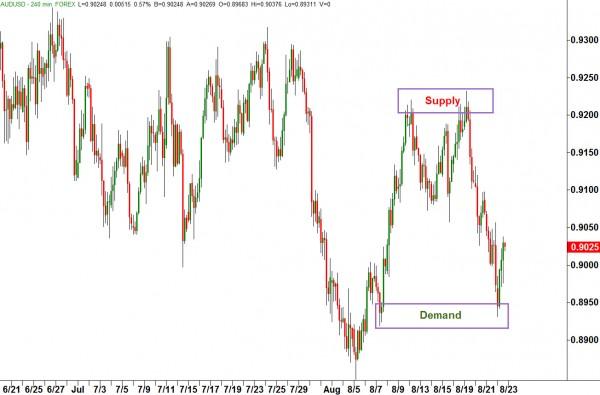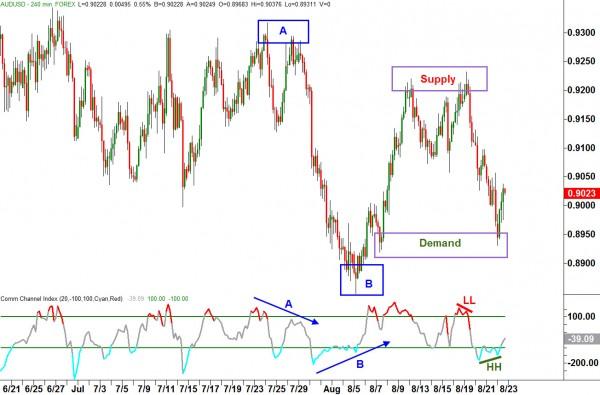As many of my readers will know from my previous pieces, I like to focus the majority of my trading analysis on nothing more than price itself. To me and my fellow instructors at Online Trading Academy, all indicators are nothing more than a result of price movement. To solely rely on a technical indicator to give you a reason to enter a trade either long or short, would be unwise because a trader needs to understand how price moves in the first place before relying on anything else to make a decision to enter or exit the market. This is why at the Academy we teach our rule-based core strategy of recognizing institutional supply and demand on any market and on any given time frame. By recognizing the behavior of institutions, our students have an edge in the marketplace which allows them to buy low and sell high with a very low risk and incredible potential reward. If you know what a picture of supply and demand looks like on a price chart, everything else becomes secondary.
As you have seen in my previous articles I have explained the concept of our core strategy and how we look at supply and demand on a price chart in detail. We identify what a buy zone looks like and what a sell zone looks like and place our trades accordingly. By marking off our areas of entry in advance, we have the added advantage of knowing exactly how much we risk on the trade should it not work in our favor and also knowing how much we are shooting for as a profit target. By eliminating the emotions and the guesswork, we allow ourselves to follow a rule-based plan and control our risk management at all times with discipline. However, it should be recognized that part of trading is also finding your own character around your plan and not every single student is going to trade in exactly the same way. We recognize this in our curriculum that we teach at the academy and as well as including detailed instructions on how to follow and implement our core strategy. Later in our curriculum we explain how too effectively use some of the technical indicator tools that are available to us as well.
Typically when I show a new student our strategy that we use at the market, they think that we have something against technical indicators because our strategy relies on price and nothing more. Let me state this though: we really don’t have anything against indicators! Rather we like to encourage the student to first understand the simplicity of trading and how buying low and selling high requires nothing more than recognizing and understanding what you’re looking for on a price chart. For some students the information on the price chart is more than enough. For others, they look to increase their edge a little bit further and that’s where technical indicators can become a very useful tool if used in the correct manner and with a solid set of rules in place. For today, I would like to talk about the Commodity Channel Index also known as the CCI.
The CCI is an oscillator and a versatile one at that. It was originally introduced to traders by Donald Lambert in an article published in 1980. Since its introduction, it has found favor with traders of multiple asset classes not solely commodities in which it was originally used. Its basic principles lie in a simple calculation, which is the difference between the typical price of the security and its simple moving average, divided by the mean absolute deviation of the typical price. Effectively it measures conditions of both overbought and oversold and also measures the strength and weakness of the current market trends. Amongst the majority of market speculators, measuring overbought and oversold is the most common use of the CCI, however I think a very simple trick is to use it as a means of looking at price divergences. Used in conjunction with a good solid understanding of supply and demand zones, CCI divergences can be a neat little tool to getting a heads up of when prices are likely to carry on or reverse. Let’s look at an example:
In the above example I have taken a four hour chart of the Australian dollar versus the US dollar and highlighted an area of Supply and an area of Demand which match the Online Trading Academy odds enhancers scores. For the majority of our students, recognising the turning points in advance and scoring the levels accordingly, is more than enough analysis required to place a trade, stoploss and target with confidence. However, with a little objective analysis, applying the CCI indicator can also give some subtle clues as to when a level is likely to hold or not. Our strategy does not work every single time. No strategy in trading works every single time but this does not mean that you can’t create an extra edge when picking out a reason to enter the marketplace. Let’s apply the CCI indicator to the same price chart and take a look at what extra information it gives us:
In this example I have marked off some specific areas to address. Firstly notice where prices fell from point A on the chart. Directly underneath this point where the CCI is applied, you can see a downward slope at the adjacent point A. The indicator itself is making lower lows and lower highs. Imagine the CCI is like a gauge of momentum. On the second test of the pivot high at point A, we can see that the CCI put in a lower low at this point with a lower force, thus suggesting an end of the upward trend and a new downward trend potential. Likewise at the pivot low of point B, we can see that the CCI was beginning to slope upwards making higher highs and higher lows, suggesting a weakening downward pressure and strengthening upward pressure. I tend to visualise the action of the indicator like a throttle with more pressure being applied in a strong trend and less pressure being applied as the trend is weakening. Think of it like more gas equals more momentum.
We can also see a use of the CCI when we already have a supply or demand zone marked off in advance. The same two levels which I showed you in the first example now have the indicator attached to them. We already knew what we wanted to do at the levels for example, selling at Supply and buying at Demand, however the CCI offers us an extra level of certainty in the trade. Notice how when price is at Supply on the second retest of the zone, the CCI forms lower lows and on the second retest of the lower Demand zone the indicator produces higher highs? This is what we call diversions between indicator and price, which always suggests a potential reversal in trend and the slowdown of momentum.
Of course we would never use divergences solely as a reason to buy or sell in the market and would always back up our trading decisions with a solid reason to enter in the first place, for example core strategy. The CCI oscillator is there as an extra tool which offers us confluence in a simple manner, so as to help us analyse objectively and give us a secondary reason to take the trade. Please remember that whenever you’re going to use a technical indicator of any kind, you always need to focus on price first and foremost. Sticking to this rule is always going to help you have a healthy and more successful trading strategy. I hope you enjoyed this piece.
Note: All information on this page is subject to change. The use of this website constitutes acceptance of our user agreement. Please read our privacy policy and legal disclaimer. Opinions expressed at FXstreet.com are those of the individual authors and do not necessarily represent the opinion of FXstreet.com or its management. Risk Disclosure: Trading foreign exchange on margin carries a high level of risk, and may not be suitable for all investors. The high degree of leverage can work against you as well as for you. Before deciding to invest in foreign exchange you should carefully consider your investment objectives, level of experience, and risk appetite. The possibility exists that you could sustain a loss of some or all of your initial investment and therefore you should not invest money that you cannot afford to lose. You should be aware of all the risks associated with foreign exchange trading, and seek advice from an independent financial advisor if you have any doubts.
Editors’ Picks
EUR/USD clings to gains above 1.0750 after US data

EUR/USD manages to hold in positive territory above 1.0750 despite retreating from the fresh multi-week high it set above 1.0800 earlier in the day. The US Dollar struggles to find demand following the weaker-than-expected NFP data.
GBP/USD declines below 1.2550 following NFP-inspired upsurge

GBP/USD struggles to preserve its bullish momentum and trades below 1.2550 in the American session. Earlier in the day, the disappointing April jobs report from the US triggered a USD selloff and allowed the pair to reach multi-week highs above 1.2600.
Gold struggles to hold above $2,300 despite falling US yields

Gold stays on the back foot below $2,300 in the American session on Friday. The benchmark 10-year US Treasury bond yield stays in negative territory below 4.6% after weak US data but the improving risk mood doesn't allow XAU/USD to gain traction.
Bitcoin Weekly Forecast: Should you buy BTC here? Premium

Bitcoin (BTC) price shows signs of a potential reversal but lacks confirmation, which has divided the investor community into two – those who are buying the dips and those who are expecting a further correction.
Week ahead – BoE and RBA decisions headline a calm week

Bank of England meets on Thursday, unlikely to signal rate cuts. Reserve Bank of Australia could maintain a higher-for-longer stance. Elsewhere, Bank of Japan releases summary of opinions.
RECOMMENDED LESSONS
Making money in forex is easy if you know how the bankers trade!
Discover how to make money in forex is easy if you know how the bankers trade!
5 Forex News Events You Need To Know
In the fast moving world of currency markets, it is extremely important for new traders to know the list of important forex news...
Top 10 Chart Patterns Every Trader Should Know
Chart patterns are one of the most effective trading tools for a trader. They are pure price-action, and form on the basis of underlying buying and...
7 Ways to Avoid Forex Scams
The forex industry is recently seeing more and more scams. Here are 7 ways to avoid losing your money in such scams: Forex scams are becoming frequent. Michael Greenberg reports on luxurious expenses, including a submarine bought from the money taken from forex traders. Here’s another report of a forex fraud. So, how can we avoid falling in such forex scams?
What Are the 10 Fatal Mistakes Traders Make
Trading is exciting. Trading is hard. Trading is extremely hard. Some say that it takes more than 10,000 hours to master. Others believe that trading is the way to quick riches. They might be both wrong. What is important to know that no matter how experienced you are, mistakes will be part of the trading process.


